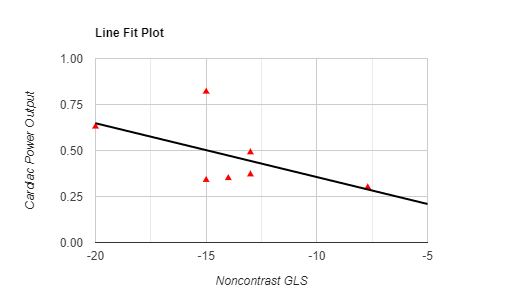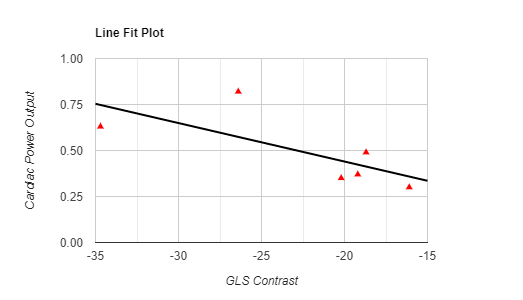Manjula G Ananthram, United States
Assistant Professor
Cardiovascular Medicine
University of Maryland
Correlation of lv-global longitudinal strain with cardiac power output in the first genetically modified porcine to human xeno transplant
Cullen Soares1, Charles C Hong1, Susie N Hong1, Peter Hanna1, Corbin E Goerlich2, Timm Dickfeld1, Alison Grazioli1, R. Michael Benitez1, Anuj Gupta1, Bartley Griffith3, Muhammad Mohiuddin3, Manjula Ananthram1.
1Department of Medicine, University of Maryland School of Medicine, Baltimore, MD, United States; 2Cardiac Xenotransplant Program, University of Maryland School of Medicine, Baltimore, MD, United States; 3Department of Surgery, University of Maryland School of Medicine, Baltimore, MD, United States
Introduction: Our institution performed the first genetically modified porcine to human cardiac xenotransplantation in a 57-year-old male. The patient survived 60 days post-transplant. (1) We sought to identify whether left ventricular global longitudinal strain (LV-GLS) correlates with invasive hemodynamics in this novel clinical scenario.
In advanced heart failure patients, the left ventricular ejection fraction may not provide enough information as to the overall function of the left ventricle. Alternative measures such as GLS and cardiac power output (CPO) have been utilized to provide additional information on left ventricular function. (2) Global longitudinal strain has previously been identified in predicting all cause mortality in heart transplant patients. (3) Cardiac Power Output (CPO) has previously been identified as a predictor of mortality in patients with a primary cardiac diagnosis (4). In heart transplant patients, it has been identified as a marker for primary graft dysfunction (5).
Method: Transthoracic echo (TTE) with and without contrast and right heart catheterization were performed after cardiac xenotransplantation. Retrospective analyses of TTE and hemodynamic data were performed to assess correlation between various parameters. The following invasive hemodynamic parameters were obtained: right atrial pressure, central venous pressure (CVP), mean arterial pressure (MAP), and thermodilution cardiac index (TDCI). Standard Doppler indices and LV-GLS with and without contrast were measured. Cardiac Power Output (CPO) was calculated: (MAP - RA pressure) x Cardiac Output / 451. RA pressure and CVP were used interchangeably for this calculation. Pearson's co-efficient between LV-GLS with and without contrast was calculated.
Results: There was a modest, non-significant negative correlation with CPO and LV-GLS without contrast (Pearson's co-efficient -0.559; p-value 0.1925), as well as a modest negative correlation with CPO and LV-GLS with contrast (Pearson's coefficient -0.721; p-value 0.1062). 

Conclusion: There was a modest, non-significant negative correlation between CPO and LV-GLS with or without Definity contrast. As such, using a non-invasive measurement of GLS to approximate CPO the cardiac xenotransplant patient may not be a valuable tool for clinical management. Limitations include the use of ECMO affecting thermodilution cardiac output and GLS measurements (6,7).
References:
[1] Griffith BP, Goerlich CE, Singh AK, et al. Genetically modified porcine-to-human cardiac xenotransplantation. N Engl J Med. 2022;387(1):35-44.
[2] Triposkiadis F, Giamouzis G, Kitai T, Skoularigis J, Starling R, Xanthopoulos A. A holistic view of advanced heart failure. Life. 2022;12(9):1298
[3] Clemmensen TS, Eiskjær H, Løgstrup BB, Ilkjær LB, Poulsen SH. Left ventricular global longitudinal strain predicts major adverse cardiac events and all-cause mortality in heart transplant patients. J Heart Lung Transplant. 2017;36(5):567-5
[4] Mendoza DD, Cooper HA, Panza JA. Cardiac power output predicts mortality across a broad spectrum of patients with acute cardiac disease. Am Heart J. 2007;153(3):366-370.
[5] Lim HS, Ranasinghe A, Chue C, Quinn D, Mukadam M, Mascaro J. Cardiac power output index and severe primary graft dysfunction after heart transplantation. J Cardiothorac Vasc Anesth. 2021;35(2):398-403.
[6] Russ M, Steiner E, Boemke W, et al. Extracorporeal membrane oxygenation blood flow and blood recirculation compromise thermodilution-based measurements of cardiac output. ASAIO Journal. 2022;68(5):721-729.
[7] Ng PY, Ma TSK, Ip A, et al. Sensitivity of ventricular systolic function to afterload during veno‐arterial extracorporeal membrane oxygenation. ESC Heart Failure. 2022;9(5):3241-3253.
